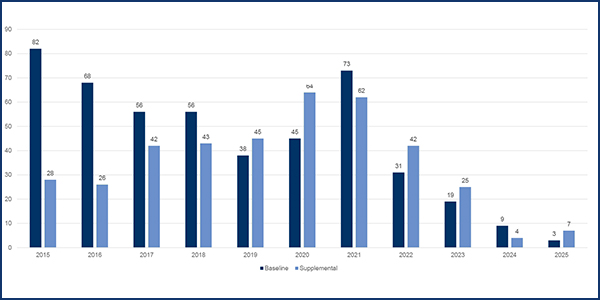PJM’s Planning Committee postponed a vote by one month on “quick-fix” manual revisions to implement the RTO’s plans to expand the use of synchrophasors and make them a requirement for certain projects under the Regional Transmission Expansion Plan (RTEP).
Stakeholders were scheduled to vote on the issue charge and endorse the proposed manual language at the June 2 PC meeting to require synchrophasors — also known as phasor measurement units (PMUs) — in all new substations and major construction projects to monitor bus voltage and line flows.
Some members said they were concerned about using the quick-fix process to endorse the changes and questioned PJM staff about missing Tariff language in the proposal.
Dave Souder, PJM’s senior director of system planning, said the PMU expansion will improve reliability and give operations staff the tools they need for the increasingly dynamic monitoring needs of the grid. Souder said he recognized some stakeholders may have issues with the quick-fix method, so he requested that members express their concerns about the proposed manual language in advance of the July PC meeting.
“I really don’t want to force a quick-fix solution down the stakeholders’ throats,” Souder said.
Shaun Murphy of PJM reviewed the PMU problem statement, issue charge and proposed solution at the meeting. In his presentation, Murphy said language is being proposed for section 1.4.1.3 of Manual 14B to add a PMU Placement Strategy (PPS) to identify the synchrophasor device coverage needed to support the RTO’s real-time synchrophasor applications. The PPS, which includes placement targets and required operational dates, would make mandatory a program that is currently voluntary.
Murphy said instituting the PPS would close the gap between research and real-time control room use and improve data reliability and oscillation detection. (See Oscillation Event Points to Need for Better Diagnostics.)
Making each substation “PMU ready” costs as much as $120,000, he said, and each substation would have two or three PMUs that cost about $10,000 each. As many as 889 projects could be created over a 12-year span if a voltage threshold of 100 kV for each unit is accepted, according to PJM. The PMU requirement would be effective for projects presented to the Transmission Expansion Advisory Committee after June 1, 2021.
Murphy said about 80 PMUs will be added each year at a cost of about $8 million annually.
Tom Hyzinski of GT Power Group said the yearly price tag seemed reasonable compared to the value of the information that could identify costly problems on the system. Hyzinski asked if there was any discussion by PJM on ways the cost could be allocated across stakeholders so that no one would be greatly impacted by the expense.
Souder said PJM was open to discussing cost allocation among stakeholders, but he said the RTO felt PMUs have to be expanded across the system to be effective. Souder said the technology would be required for both baseline and supplemental projects to spread the technology.
Dave Mabry of the PJM Industrial Customer Coalition (ICC) said he was thankful for the educational session PJM held on May 26 on PMUs and their benefits to the system. He asked if there were any Tariff changes considered in the PJM proposal, noting that the Tariff makes references to PMUs in generation interconnection.
Souder said PJM’s legal review concluded the manual language was sufficient.
Mabry said the ICC opposed using the quick-fix solution and thinks the issue would benefit from further consideration by stakeholders regarding the implementation strategy and cost allocation. He said the education session convinced the ICC to support the problem statement but that the group still has reservations about the PJM proposed solution and is concerned that it will increase the justification of supplemental projects, which are reserved for incumbent transmission owners and not subject to competitive bidding.
“We don’t want to implicitly approve supplemental projects we have questions about,” he said. “Our concern is whether PMUs are going to become a nexus for trying to justify supplemental projects.”
Souder said he understood that stakeholders have concerns about supplemental projects but said if PJM only requires PMUs in baseline projects, it will limit the ability to propagate the technology across the system.
“It truly is a catch-22,” Souder said. “We need the data across the systems so we can fully utilize the tools.”





